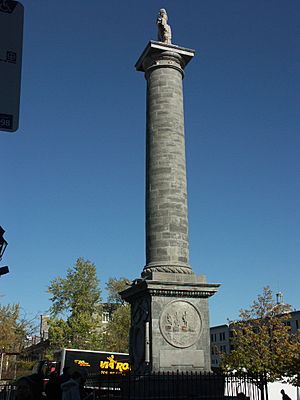Nelson's Column, Montreal facts for kids
| French: Colonne Nelson | |
 |
|
| Coordinates | 45°30′30″N 73°33′14″W / 45.50833°N 73.55389°W |
|---|---|
| Location | Place Jacques-Cartier Old Montreal |
| Designer | Robert Mitchell |
| Material | stone |
| Height | 62 ft (19 m) |
| Beginning date | August 17, 1809 |
| Dedicated to | Horatio Nelson |
Nelson's Column (French: colonne Nelson) is a famous monument in Montreal, Canada. It was designed by a Scottish architect named Robert Mitchell. The column was built in 1809 in Place Jacques-Cartier. It honors Admiral Horatio Nelson, a British naval hero. He died during the Battle of Trafalgar.
After a similar column in Dublin was destroyed, Montreal's column became the second-oldest "Nelson's Column" in the world. The Nelson Monument in Glasgow is older. Montreal's column is also the oldest monument in the city. It is the oldest war monument in all of Canada. People from both British and French backgrounds in Montreal helped pay for it.
Contents
Nelson's Column: A Montreal Landmark
Building a Tribute to Nelson
The Idea and Fundraising
People in Montreal first heard about Nelson's death in late 1805. News traveled slowly back then. A messenger interrupted a party to share the news. A man named Samuel Gerrard quickly suggested building a monument. He wanted to honor Nelson's memory and his victory over Napoleon's navy. Many people immediately offered money to help. A list was kept open for more donations.
In 1806, a group of people formed a committee. They included important figures like John Richardson and Louis Chaboillez. This group worked to raise money and plan the monument. Many different people gave money. This included French Canadians who did not like the French Revolution or Napoleon. They saw Nelson's victory as a good thing.
Choosing the Location
Montreal's leaders got a piece of land for the monument. It was once part of the gardens of the Château Vaudreuil. This old building burned down in 1803. The garden area became a public square. It was first called New Market Place. Later, it was renamed Jacques Cartier Square in 1847.
Special Materials and Construction
The committee hired a company in London called Coade & Sealy. They were asked to design a strong monument. The column itself was made of grey limestone. The statue and decorations were made from Coade stone. This was a special material invented by the company.
The monument was shipped to Montreal in many pieces. It arrived in April 1808. A local stonemason named William Gilmore put the seventeen parts together. The base was laid on August 17, 1809. The total cost was almost £1,300.
The Oldest War Monument
Montreal's column was one of the first monuments built for Nelson anywhere. Some say it was the very first. However, Dublin's Nelson's Pillar was finished around the same time in 1809. Dublin was part of the British Empire then. The Dublin Pillar was later destroyed in 1966.
The original statue of Horatio Nelson was on top of the column for many years. In 1997, it was moved to the Montreal History Museum. This was done to protect it. A copy of the statue now stands on the column.
A Special Ceremony in 1900
In October 1900, the column was restored. A special ceremony took place to celebrate. Speakers from different communities in Montreal attended. A French-Canadian speaker, Louis François Georges Baby, said that both British and French Montrealers helped build the monument. Another speaker, Henri Césaire Saint-Pierre, even suggested the idea came from a French-Canadian. He was likely thinking of Samuel Gerrard, who was actually Anglo-Irish. Saint-Pierre said the monument taught a lesson about "duty performed," no matter your background. Other speakers represented the Irish and Scots-Quebecer communities.
Other Nelson Monuments Around the World
Many other monuments were built to honor Nelson. Here are a few examples:
- 1806: The Nelson Monument in Glasgow, Scotland. It is a tall, pointed stone monument.
- 1806: Nelson's Tower in Forres, Moray.
- 1808: Nelson's Pillar in Dublin, Ireland. It was destroyed by a bomb in 1966.
- 1809: Statue of Horatio Nelson, Birmingham by Richard Westmacott, in the Bull Ring in Birmingham, England.
- 1809: A column with a decorative urn in Hereford, England. A statue was planned but not enough money was raised.
- 1813: A statue of Lord Nelson in Trafalgar Square, Bridgetown, Barbados. This one is older than the more famous London column.
- 1807-1815: Nelson Monument, Edinburgh, a tower on top of Calton Hill in Edinburgh, Scotland.
- 1819: The Britannia Monument at Great Yarmouth, England. It is a tall column with a statue of Britannia on top.
- 1840-1843: Nelson's Column in London, England. This is the most famous one.
- 1853: Nelson's Needle on top of Portsdown Hill, Portsmouth, England. Sailors from HMS Victory paid for it.
Images for kids
-
Nelson's Column as seen from Place Jacques-Cartier, 2005
-
The original statue of Nelson, now at the Centre d'histoire de Montréal.
Gallery
See also
 In Spanish: Columna Nelson para niños
In Spanish: Columna Nelson para niños











